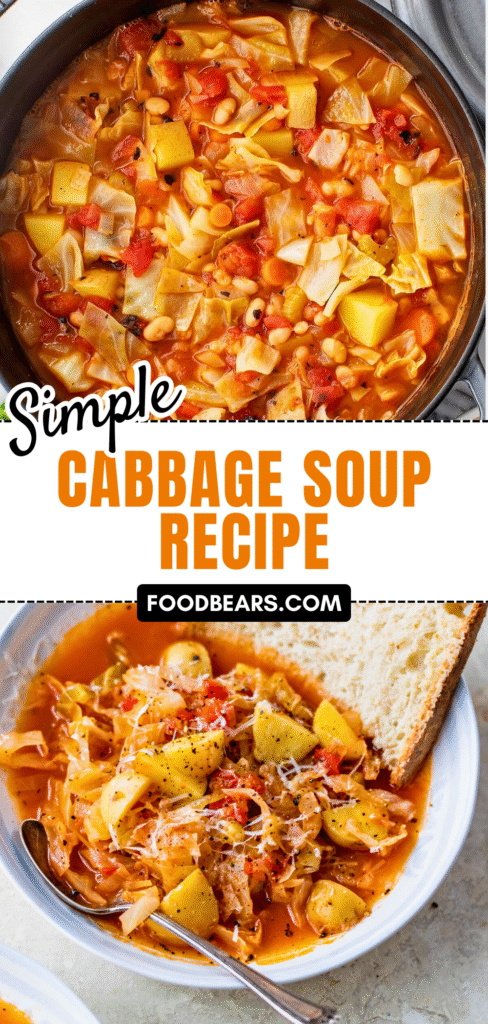Quick & Cozy Cabbage Soup Recipe for Weight Loss in 2025

There’s something special about a pot of soup bubbling away on the stove. It warms your kitchen, fills the air with inviting aromas, and delivers comfort in every bowl.
Out of all the soups you can make, cabbage soup stands out as one of the most nourishing, budget-friendly, and versatile options.
Forget the fad diets that once gave cabbage soup a weight-loss label; this dish is so much more. Packed with vegetables, nutrients, and fiber, it’s a hearty and wholesome meal you’ll love all year long. Best of all, it comes together in under 30 minutes, making it faster than takeout.
Think of cabbage soup as a blank canvas. Stick to the classic recipe, or customize it with beans, grains, or meat. In this guide, you’ll learn everything to make it your own.
The Magic of Cabbage Soup

Before we dive into the recipe, let’s take a quick look at what makes cabbage soup so special.
1. Healthy and Nutritious
Cabbage is a nutrient powerhouse. It’s packed with vitamins C and K, antioxidants, and fiber. Being a cruciferous vegetable, it supports digestion, helps fight inflammation, and promotes long-term wellness.
When combined with carrots, celery, onions, and herbs, cabbage soup becomes a low-calorie but high-satisfaction meal. It fills you up without weighing you down.
2. Budget-Friendly Comfort Food
If you’re looking for a recipe that’s both delicious and easy on the wallet, this is it. A single head of cabbage can feed an entire family and still leave leftovers for lunch the next day.
3. Adaptable for Every Diet
- Vegetarian or Vegan? Stick with vegetable broth.
- Low-Carb/Keto? Skip potatoes and grains, and enjoy a lighter version.
- Gluten-Free? This soup naturally fits the bill.
- Protein Boost Needed? Add beans, lentils, chicken, or sausage.
This flexibility makes it perfect for families with different dietary needs.
Ingredients You’ll Need
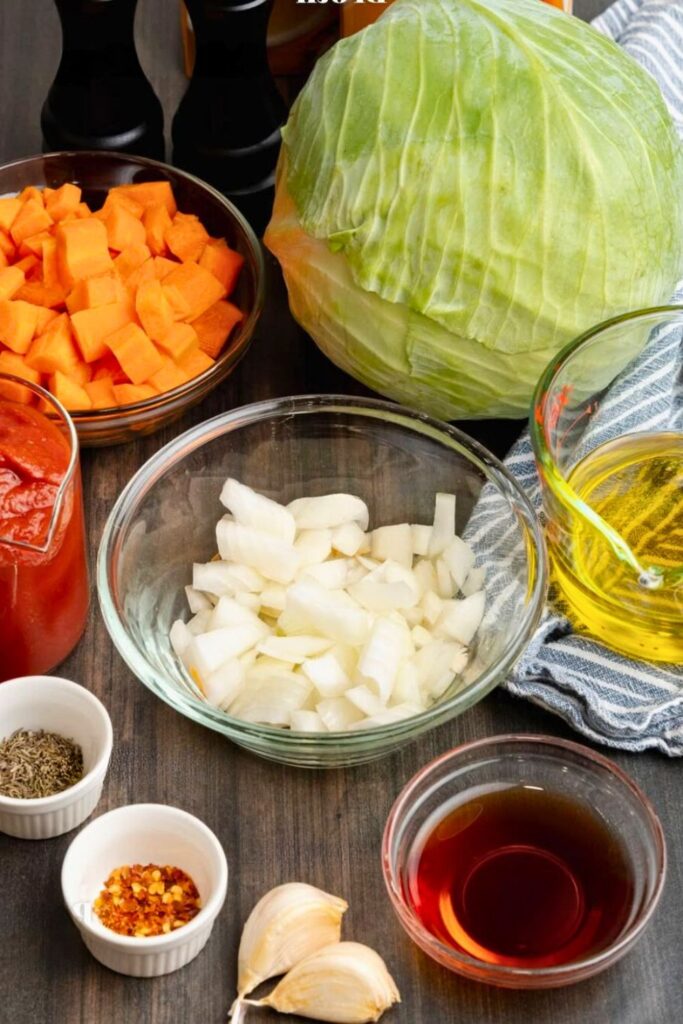
Here’s a clear breakdown of everything you need for this comforting cabbage soup, organized in a handy table so you can plan and shop with ease:
| Category | Ingredient | Details / Notes |
| Base Vegetables | Celery | 2 stalks, diced into bite-sized pieces |
| Carrot | 1 large carrot, diced (peeled or unpeeled, your choice) | |
| Onion | 1 medium onion, diced | |
| Star Ingredient | Cabbage | ½ small to medium head (about 6–8 cups chopped); green cabbage is classic |
| Aromatics & Herbs | Garlic | 2 cloves, minced |
| Dried oregano | ½ teaspoon | |
| Dried basil | ½ teaspoon | |
| Salt | ½ teaspoon, or to taste | |
| Fresh parsley | About ¼ cup, chopped (plus extra for garnish) | |
| Liquids | Olive oil | 2 tablespoons, for sautéing |
| Vegetable broth (or chicken broth) | 4 cups; adjust with more if you prefer a thinner soup | |
| Diced tomatoes (canned) | 1 can (14 oz); plain, basil-seasoned, or fire-roasted for extra flavor | |
| Finishing Touches | Lemon juice | 1–2 tablespoons, fresh squeezed, to brighten the flavor |
| Black pepper | Freshly cracked, to taste |
This ingredient list strikes the perfect balance between pantry staples and fresh produce, making cabbage soup both accessible and flavorful.
Step-by-Step: How to Make Cabbage Soup
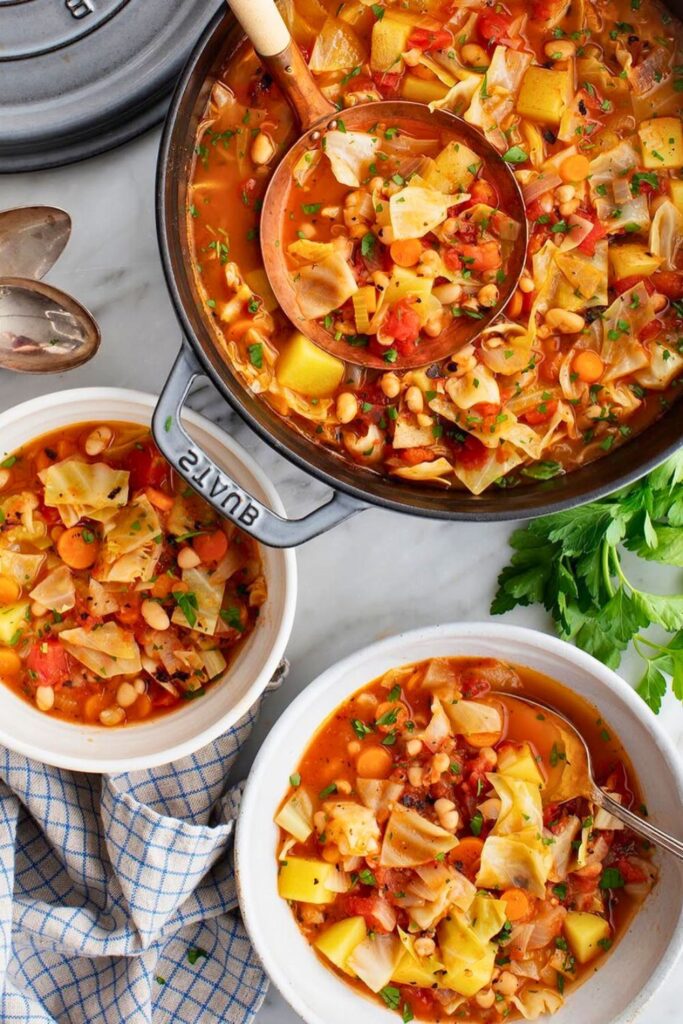
Cooking a great soup isn’t just about throwing vegetables into a pot and waiting; it’s about layering flavors. Each step adds something special, and when done right, the result is a bowl of comfort that feels both wholesome and delicious.
Below, we’ll break down every step of making this cabbage soup so you can understand not just what to do, but why it matters.
Step 1: Prep the Vegetables
Like any good soup, cabbage soup begins with prep. It may feel like the “boring” part, but trust me, this step sets the tone for your entire dish.
Chopping vegetables evenly ensures they cook at the same pace and gives every spoonful the right balance of textures.
- Celery: Take 2 stalks, rinse them well, and slice them lengthwise into 2–3 strips before chopping across. This technique creates small, bite-sized pieces that blend seamlessly into the soup. Celery provides a mild, slightly salty flavor that complements the sweetness of carrots and the sharpness of onions.
- Carrot: One large carrot is all you need. You can peel it if you prefer a cleaner look, but the skin has nutrients and a rustic charm, so peeling is optional. For easy chopping, cut the carrot in half horizontally, then cut each piece lengthwise to create a flat surface (this keeps it from rolling around). Slice into small cubes or half-moons. Carrots bring a subtle sweetness that balances cabbage’s earthiness.
- Onion: Use one medium onion, diced into small chunks. Onions are like the foundation of a house, they build structure and provide depth to the flavor. Their natural sugars caramelize slightly during cooking, creating a sweet-savory base.
- Cabbage: Now for the star ingredient. Take half of a small to medium cabbage (about 6–8 cups chopped). First, cut it into quarters, then slice out the hard core from each section. Chop the leaves into 1-inch squares big enough to hold their shape but small enough to eat without struggling. Don’t worry if your half cabbage gives you more than 8 cups; cabbage sizes vary, and the recipe is flexible. Extra cabbage can be saved for stir-fries, coleslaw, or even a quick sauté with garlic.
- Parsley: Roughly chop ¼ cup of fresh parsley. This will be used at the end for a bright, herby finish. Parsley might seem like a garnish, but in reality, it lifts the soup, cutting through the richness of cooked vegetables with a burst of freshness.
Pro Tip: Keep all your chopped veggies in separate bowls. This makes it easier to add them at the right time without scrambling.
Prepping may take 10 minutes, but it transforms your cooking from stressful to smooth. By the time your pot heats up, you’ll be ready to move seamlessly into cooking mode.
Step 2: Build the Flavor Base
Great soups are built in layers, and this is where it all begins with sautéing aromatics.
- Heat 2 tablespoons of olive oil in a large pot over medium-high heat. The oil not only prevents sticking but also helps draw out the flavors of the vegetables.
- Add the diced onion, carrot, and celery (your mirepoix). Cook for about 4–5 minutes, stirring occasionally. The goal is to soften them, not brown them. As they cook, they release their natural sugars, creating a savory-sweet base.
Now comes the magic:
- Add 2 minced garlic cloves. Garlic burns quickly, so only cook it for about 30–60 seconds until fragrant.
- Sprinkle in ½ teaspoon dried oregano, ½ teaspoon dried basil, and ½ teaspoon salt. These herbs infuse the oil with flavor and spread evenly throughout the soup.
This step may seem small, but it’s powerful. Think of it like setting the soundtrack to a movie; the right notes make everything else feel richer. Without this base, the soup would taste flat, no matter how much cabbage you add later.
Pro Tip: If you want to enhance the flavor even more, add a tiny pinch of red pepper flakes or smoked paprika at this stage. It won’t overpower the soup but will give it depth.
Step 3: Add the Cabbage
Now it’s time to introduce the star of the show, cabbage.
- Toss in 6–8 cups of chopped cabbage. Don’t be alarmed if it looks like too much; cabbage shrinks significantly as it cooks.
- Stir well so that every piece is coated with the flavored oil and aromatics.
- Let it cook for about 5 minutes. This process is called “sweating,” and it helps soften the cabbage while releasing its mild sweetness.
At this point, you’ll notice your kitchen filling with a comforting, earthy aroma. The cabbage takes on some of the herb and garlic flavors from earlier, ensuring it blends harmoniously into the soup.
Pro Tip: Keep stirring every minute or so. Cabbage can stick to the bottom of the pot if left unattended, and you want it to soften evenly.
This step also allows the cabbage to develop a slight caramelization, which boosts flavor. Think of it like toasting bread before making a sandwich, it just makes everything better.
Step 4: Add Liquids and Simmer
Once your vegetables have softened and your kitchen smells amazing, it’s time to turn them into soup.
- Pour in 4 cups of vegetable broth. This forms the liquid base, adding richness and body. If you’re not a vegetarian, chicken broth works beautifully too.
- Add one 14-ounce can of diced tomatoes. You can use plain, basil-flavored, or even fire-roasted for a smoky edge. The acidity of the tomatoes balances the sweetness of the vegetables and brightens the overall flavor.
Give everything a good stir to combine.
Now, bring the soup to a gentle boil, then reduce the heat to medium and let it simmer uncovered for about 10 minutes. During this time, the vegetables soften fully, and all the flavors meld together.
Pro Tip: If your pot looks too crowded with cabbage, don’t panic. Just add an extra cup or two of broth (or even water) to make it more brothy. Soup is forgiving; adjust it to your liking.
Simmering is where the magic happens. It’s like giving the ingredients time to introduce themselves to each other, blending into a harmonious whole. Resist the urge to rush; those 10 minutes of gentle bubbling make all the difference.
Step 5: Finish with Freshness
Once the cabbage and veggies are tender, it’s time for the final touches that elevate this soup from good to unforgettable.
- Remove the pot from the heat.
- Stir in ¼ cup of chopped fresh parsley. This adds brightness and a pop of green color.
- Squeeze in 1–2 tablespoons of fresh lemon juice. Don’t skip this! The acidity wakes up all the flavors and prevents the soup from tasting flat.
Finally, season with freshly cracked black pepper to taste.
Pro Tip: Taste before serving. Does it need more salt? Another squeeze of lemon? Adjusting at the end is key to making your soup truly sing.
This step is like adding jewelry to an outfit; it doesn’t change the foundation, but it makes everything shine.
Step 6: Serve and Enjoy
Now comes the best part: eating!
- Ladle the hot soup into bowls. Each scoop should give you a rainbow of vegetables and tender cabbage.
- Garnish with extra parsley and a sprinkle of black pepper.
Serve the soup with a slice of crusty bread, a grilled cheese sandwich, or even a simple side salad. It’s hearty enough for dinner but light enough for lunch.
As you take that first spoonful, notice the layers of flavor: the sweetness of carrots, the gentle bite of cabbage, the freshness of lemon, and the herby lift from parsley. It’s warm, nourishing, and comforting like a hug in a bowl.
Pro Tip: Make extra. Cabbage soup tastes even better the next day as the flavors deepen overnight. Store in the fridge for up to 5 days or freeze portions for a quick, healthy meal anytime.
Tips for the Best Cabbage Soup
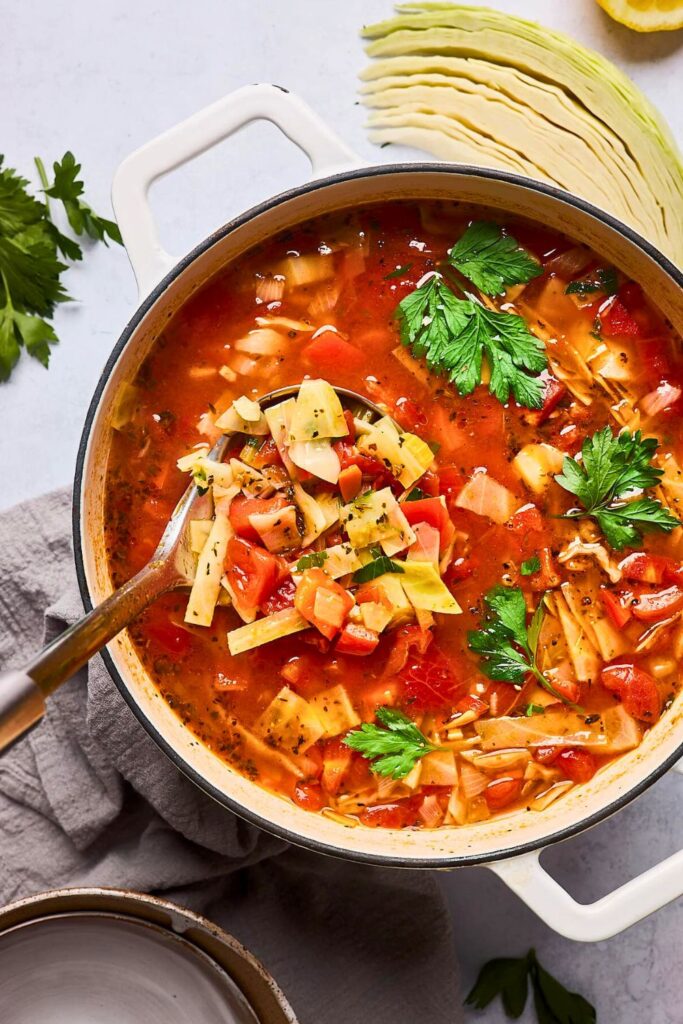
Cabbage soup is a forgiving recipe, but a few smart tweaks can transform it from simple to spectacular. Here are five tried-and-true tips to help you get the most out of your pot of soup:
1. Chop Vegetables Evenly
Uneven cuts mean uneven cooking. Large chunks of carrot may still be firm while the celery turns mushy. Aim for bite-sized, consistent pieces so every spoonful feels balanced. This also makes the soup easier to eat, especially if you’re serving kids or picky eaters.
2. Sweat the Cabbage First
Don’t rush to add broth right after tossing in the cabbage. Let it sweat for 5 minutes with the mirepoix and spices. This softens the leaves, enhances their natural sweetness, and prevents the soup from tasting raw or overly sharp. Think of it as “warming up” the star ingredient.
3. Taste and Adjust Seasoning at the End
Salt levels change as the soup simmers, and canned tomatoes and broth can vary in saltiness. Always taste before serving. If it feels flat, add a squeeze of lemon juice. If it feels too acidic, add a pinch of sugar. Seasoning is where you make the soup truly yours.
4. Don’t Overcook the Vegetables
Cabbage and carrots should be tender but not mushy. Overcooking dulls their color and texture. The key is to simmer just long enough, about 10 minutes, after adding the broth. Remember, the soup will continue cooking slightly even after you remove it from the heat.
Variations to Try
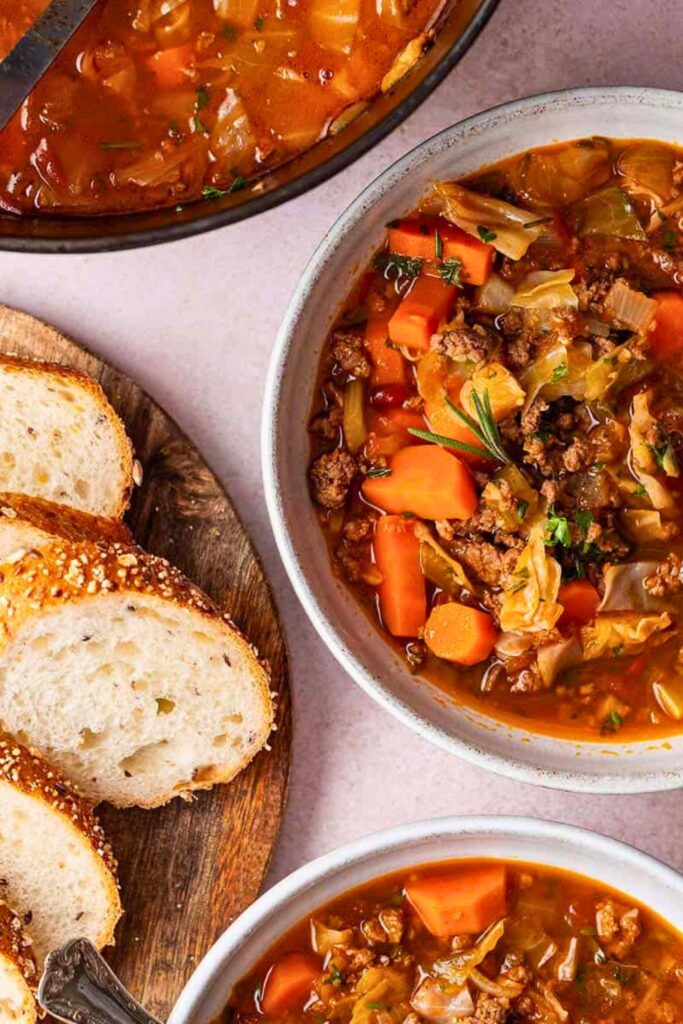
Cabbage soup is one of the most adaptable recipes you can make. Whether you’re craving something spicy, creamy, or protein-packed, this dish bends to your creativity.
Here’s a handy table of variations to inspire you:
| Variation | How to Make It | Flavor Profile |
| Protein Boost | Add shredded chicken, turkey, sausage slices, or chickpeas/white beans. | Heartier, more filling, balanced with protein. |
| Spicy Cabbage Soup | Stir in red pepper flakes, smoked paprika, or a diced jalapeño. | Bold, warming heat with smoky undertones. |
| Creamy Cabbage Soup | Blend half the soup and stir back in, or add cream/coconut milk at the end. | Smooth, rich, and comforting with a velvety finish. |
| Minestrone Style | Toss in small pasta (like ditalini) or rice; add zucchini or green beans. | Rustic Italian-inspired with extra body. |
| Global Twist | Try curry powder + coconut milk (Indian style) or soy sauce + ginger (Asian style). | Exotic, flavorful, and adventurous variations. |
| Low-Carb / Keto | Skip starchy add-ins and keep it veggie-heavy with zucchini, spinach, or kale. | Light, nutrient-dense, and diet-friendly. |
| Garden Harvest | Add seasonal vegetables like bell peppers, peas, corn, or mushrooms. | Colorful, fresh, and slightly sweet. |
Pro Tip: Always adjust broth when adding more ingredients. More veggies, grains, or beans soak up liquid, so add an extra cup or two to keep it soupy instead of stew-like.
Health Benefits of Cabbage Soup

Cabbage soup isn’t just cozy, it’s seriously good for you. Let’s break down its top health perks:
1. Rich in Fiber for Digestion
Cabbage is loaded with dietary fiber, which helps regulate digestion and keeps you feeling full. Pairing it with other fiber-rich vegetables like carrots and celery makes this soup excellent for gut health and weight management.
2. Boosts Immunity
Thanks to high levels of vitamin C and antioxidants, cabbage soup supports the immune system. It’s a fantastic choice during cold and flu season when you need that extra shield against bugs.
3. Anti-Inflammatory Powerhouse
Cabbage belongs to the cruciferous vegetable family (like broccoli and kale). These veggies contain natural compounds that reduce inflammation and may help lower the risk of chronic diseases.
4. Low in Calories but Satisfying
This soup is naturally low in calories yet filling, making it a great option for those looking to maintain or lose weight without feeling deprived. Unlike crash diets that push cabbage soup as a “detox,” this recipe works best as a nourishing, balanced meal you can enjoy regularly.
Final Thoughts
Cabbage soup proves that simple ingredients can create something extraordinary. With just a handful of vegetables, herbs, and pantry staples, you can prepare a dish that’s cozy, nourishing, and endlessly versatile. It’s not just about eating a bowl of soup, it’s about enjoying comfort in every spoonful.
Whether you keep it classic, add protein for a heartier version, or spice it up with bold flavors, this soup adapts beautifully to your taste and lifestyle. It’s budget-friendly, meal-prep friendly, and family-approved, making it a true staple for every season.
Next time you’re craving something warm, wholesome, and satisfying, let this cabbage soup recipe be your go-to. It’s the kind of dish that reminds us why home cooking matters. It’s nourishing, it’s comforting, and it always brings people together.
More Recipes for Cozy Nights
Looking for more hearty, family-friendly soups to add to your meal plan? Try these next:
- Quick 20-Min Tomato Basil Soup Recipe for Families – A classic, cozy bowl of comfort made in just 20 minutes.
- Simple Stuffed Pepper Soup Recipe for Lazy Days – All the flavors of stuffed peppers, transformed into a hearty one-pot soup.
- Hearty 40-Min Corn Chowder Recipe for Families – Creamy, filling, and loaded with sweet corn and vegetables for the perfect family meal.
